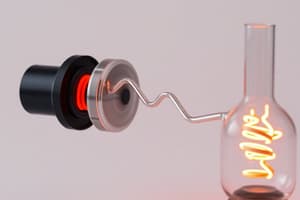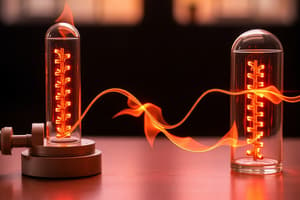Podcast
Questions and Answers
What is the significance of the Zeroth Law of Thermodynamics?
What is the significance of the Zeroth Law of Thermodynamics?
- It explains the direction of heat flow.
- It relates entropy to temperature changes.
- It defines thermal equilibrium among system components. (correct)
- It establishes the concept of energy conservation.
Which statement correctly describes the First Law of Thermodynamics?
Which statement correctly describes the First Law of Thermodynamics?
- Heat cannot be converted to work in any process.
- Energy can be created and destroyed in a closed system.
- The change in internal energy is equal to heat added to the system minus the work done by the system. (correct)
- The internal energy of an ideal gas decreases with increasing work done on it.
In which process does the system maintain a constant volume?
In which process does the system maintain a constant volume?
- Isochoric Process (correct)
- Isobaric Process
- Adiabatic Process
- Isothermal Process
What does the Second Law of Thermodynamics imply about entropy?
What does the Second Law of Thermodynamics imply about entropy?
How is enthalpy (H) defined in a thermodynamic context?
How is enthalpy (H) defined in a thermodynamic context?
Which process is characterized by no heat being exchanged with the surroundings?
Which process is characterized by no heat being exchanged with the surroundings?
In the context of heat engines, what does the efficiency formula η = (Q_h - Q_c) / Q_h represent?
In the context of heat engines, what does the efficiency formula η = (Q_h - Q_c) / Q_h represent?
Which of the following statements about the Carnot Cycle is true?
Which of the following statements about the Carnot Cycle is true?
How does the Third Law of Thermodynamics relate to temperature and entropy?
How does the Third Law of Thermodynamics relate to temperature and entropy?
What is the primary function of refrigerators in thermodynamics?
What is the primary function of refrigerators in thermodynamics?
Flashcards are hidden until you start studying
Study Notes
Thermodynamics
Basic Concepts
- Definition: Study of energy transfer, heat, and work in physical systems.
- System and Surroundings: A system is the part of the universe being studied, while the surroundings are everything else.
Laws of Thermodynamics
- Zeroth Law: If two systems are in thermal equilibrium with a third system, they are in thermal equilibrium with each other.
- First Law: Energy cannot be created or destroyed (Conservation of Energy). Change in internal energy (ΔU) = Heat added to the system (Q) - Work done by the system (W).
- Second Law: In any energy transfer, the total entropy of an isolated system can never decrease. Heat flows spontaneously from hot to cold.
- Third Law: As temperature approaches absolute zero, the entropy of a perfect crystal approaches zero.
Key Terms
- Internal Energy (U): Total energy contained within a system.
- Enthalpy (H): Total heat content, H = U + PV (where P = pressure, V = volume).
- Entropy (S): Measure of disorder or randomness in a system.
- Heat (Q): Energy transferred due to temperature difference.
- Work (W): Energy transfer that is not heat; can be done by or on the system.
Processes
- Isothermal Process: Temperature remains constant (Q = W).
- Adiabatic Process: No heat exchanged with surroundings (Q = 0).
- Isochoric Process: Volume remains constant (W = 0, ΔU = Q).
- Isobaric Process: Pressure remains constant (Q = ΔH).
Thermodynamic Cycles
- Carnot Cycle: Idealized cycle consisting of two isothermal and two adiabatic processes; maximum efficiency.
- Otto Cycle: Combustion engine cycle; consists of isochoric and adiabatic processes.
- Rankine Cycle: Used in steam engines; includes isobaric and isochoric processes.
Applications
- Heat Engines: Converts heat energy into mechanical work.
- Refrigerators: Transfers heat from a cold reservoir to a hot reservoir using work.
- Thermal Expansion: Change in dimensions of materials as temperature changes.
Important Equations
- Work Done: W = ∫ PdV (for an ideal gas).
- First Law: ΔU = Q - W.
- Efficiency of Heat Engine: η = (Q_h - Q_c) / Q_h or η = W_out / Q_h.
Real-World Implications
- Understanding heat and work processes is vital in engineering, environmental science, and various industries.
- Thermal management is critical for electronics, building systems, and renewable energy generation.
Thermodynamics
- The study of energy transfer, heat, and work in physical systems.
- A system is the part of the universe being studied, while the surroundings are everything else.
Laws of Thermodynamics
- Zeroth Law: If two systems are in thermal equilibrium with a third system, they are in thermal equilibrium with each other.
- First Law: Energy cannot be created or destroyed (Conservation of Energy).
- Change in internal energy (ΔU) = Heat added to the system (Q) - Work done by the system (W).
- Second Law: In any energy transfer, the total entropy of an isolated system can never decrease.
- Heat flows spontaneously from hot to cold.
- Third Law: As temperature approaches absolute zero, the entropy of a perfect crystal approaches zero.
Key Terms
- Internal Energy (U): Total energy contained within a system.
- Enthalpy (H): Total heat content, H = U + PV (where P = pressure, V = volume).
- Entropy (S): Measure of disorder or randomness in a system.
- Heat (Q): Energy transferred due to temperature difference.
- Work (W): Energy transfer that is not heat; can be done by or on the system.
Processes
- Isothermal Process: Temperature remains constant (Q = W).
- Adiabatic Process: No heat exchanged with surroundings (Q = 0).
- Isochoric Process: Volume remains constant (W = 0, ΔU = Q).
- Isobaric Process: Pressure remains constant (Q = ΔH).
Thermodynamic Cycles
- Carnot Cycle: Idealized cycle consisting of two isothermal and two adiabatic processes; maximum efficiency.
- Otto Cycle: Combustion engine cycle; consists of isochoric and adiabatic processes.
- Rankine Cycle: Used in steam engines; includes isobaric and isochoric processes.
Applications
- Heat Engines: Converts heat energy into mechanical work.
- Refrigerators: Transfers heat from a cold reservoir to a hot reservoir using work.
- Thermal Expansion: Change in dimensions of materials as temperature changes.
Important Equations
- Work Done: W = ∫ PdV (for an ideal gas).
- First Law: ΔU = Q - W.
- Efficiency of Heat Engine: η = (Q_h - Q_c) / Q_h or η = W_out / Q_h.
Real-World Implications
- Understanding heat and work processes is vital in engineering, environmental science, and various industries.
- Thermal management is critical for electronics, building systems, and renewable energy generation.
Studying That Suits You
Use AI to generate personalized quizzes and flashcards to suit your learning preferences.




